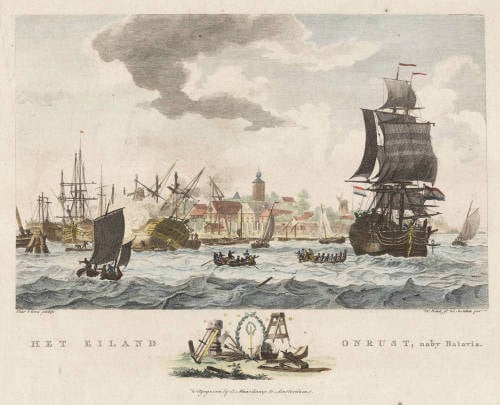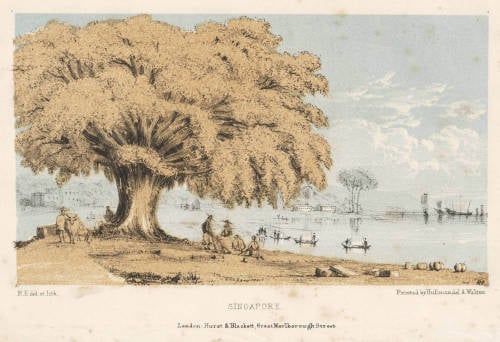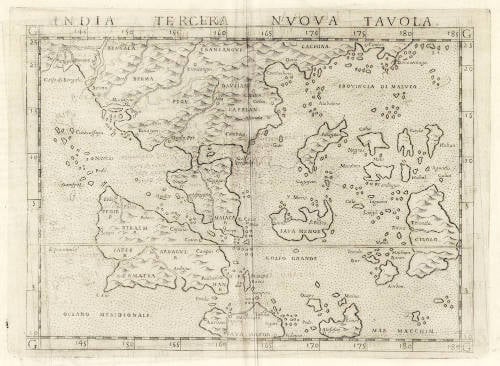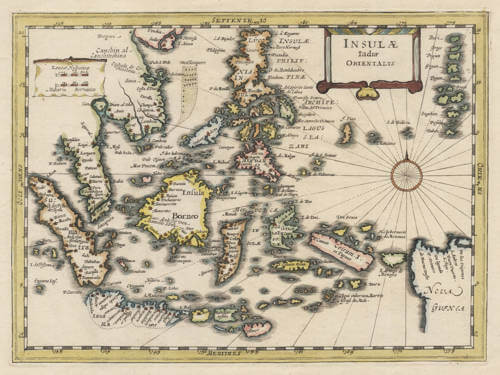Leen Helmink Antique Maps
Antique view of Onrust Island in Batavia Bay
Stock number: 19231
Zoom ImageTitle
Het Eiland Onrust, naby Batavia
First Published
Amsterrdam, 1782
Size
17.5 x 28.2 cms
Technique
Condition
excellent
Price
$ 750.00
(Convert price to other currencies)
Description
Famous view of the Island of Onrust (Unrest), one of the VOC's heavily fortified strongholds in the Bay of Batavia. The island primarily served as the VOC's shipyard for the massive naval needs of the VOC. East Indiamen were careened and repaired here, but it also had a gunpowder magazine, and a lot of warehouses for spices and fresh water storage. It had reservoirs for trees, processed by sawing windmills to produce ship planking. There was also a smithy to serve the shipyard. Near the waterfront were special cranes to pull ships on their side for careening and repairs. Sometimes small ships were built for local use. The iskand had developed into a small town protected by a fortress of five bastions. VOC employees were only allowed to leave the island twice a year.
James Cook famously had to have his Endeavour repaired here, after running on a reef in Queensland on his first voyage. He writes that Onrust is the best shipyard on the Eastern Hemisphere, but complains about the high price that the VOC charges him for it, and the fact that he had to wait very long because the VOC's own ships had priority. Cook remarks that Batavia is so unhealthy that he lost more men there (to malaria, dysentery, etc) than during the rest of his entire circumnavigation.
The view is engraved by Sallieth, after a now probably lost painting by Hendrick Kobell Jr. A companion painting of Batavia roadstead has survived.
Condition
First edition. Thick paper. No restorations or imperfections. Strong and even imprint of the copperplate. Vibrant original colour, which is exceptionally rare for this print. An excellent collector's copy of the best view of the island.
Hendrik Kobell Jr (1751-1779)
If Hendrik Kobell Jr had not jumped out of a window in a delirium at age 28, then today we would remember him as the most celebrated painter of his day.
Already as a little boy, in Rotterdam, he attempted to "draw, or cut from paper, the ships and barges, that he saw in the harbour of his hometown, or on the river that streamed through it” thus written by his biographers Van Eijnden and Van der Willigen. In 1770, Kobell entered a two year education at the Amsterdam Art Academy. Two years after finishing this education, he married in Delfshaven the daughter of a gin distiller The later cattle painter Jan Kobell II (1778-1814) was one of two sons from this marriage.
The fame of Hendrik Kobell junior is especially based on his beautifully worked out drawings and watercolours, which found their way into the collections of prominent collectors like Jacob de Vos and Cornelis Ploos van Amstel. It was only later in life, that the artist of drawings began to translate the fruits of his pencil into oil paintings, most probably first during his time in England during the second half of the 1770s. For this reason, paintings from his hand are of exceptional rarity. In1775, stadtholder Willem V acquired two of Kobells paintings for his gallery at the Buitenhof Square in the Hague. Of that Kobell pair, the pendant [pair of paintings designed to hang together] ’English Warschips and a Moroccon threemaster in distress during a thunderstorm off the North African coast’ is now part of the Rijksmuseum collection.
Literature
Wiepke Loos (ed.), Het Galante Tijdperk. Schilderijen uit de collectie van het
Rijksmuseum, 1700-1800, Zwolle 1995, pp. 74-75.
R. van Eijnden en A. van der Willigen, Geschiedenis der Vaderlandsche schilderkunst sedert de helft der XVIII eeuw, Haarlem 1816-1840, deel 2, pp. 373-76.
Matthias De Sallieth (1749-1791)
Matthias (or Mathias or Mattheus) de Sallieth was a Czech etcher/engraver of copperplates, stipple engravings and aquatint. He started as a plate worker for J.E Mansfeld in Vienna. Afterwards he moved to Paris, where he worked for J.P. Le Bas. In 1778 he moved to Holland and installed himself at Schoonderloo, near Delfshaven and Rotterdam.
Related Categories
Related Items






